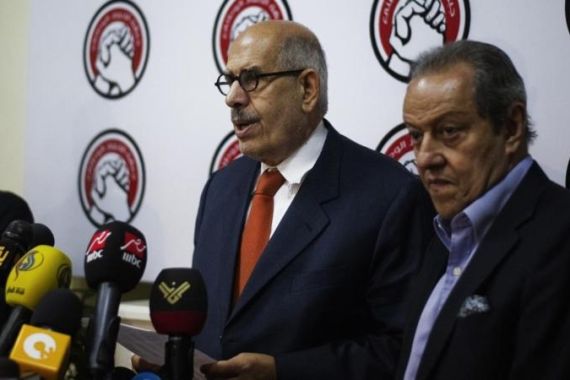Grief and fear follow violent Cairo clearing
Police officers used tear gas and bullets to disperse demonstrators in a day of deadly unrest.

Nasr City, Cairo – The day did not go anything like planned, at least if media reports and statements from Egypt’s Ministry of Interior were any indication.
There was no gradual choking off of the sit-in at the Rabaa al-Adawiya mosque, where tens of thousands held a vigil calling for the reinstatement of deposed President Mohamed Morsi.
By 6:30am on Wednesday, just two days after news that any sort of forced evacuation would be delayed pending further review, police had surrounded the Rabaa sit-in.
An hour later, small clashes began between people trying to get into the sit-in and men in civilian clothes standing with police.
Those wanting to get into the area or simply waiting for family members trapped inside were chased down the street by the plain-clothed men throwing rocks as the first hint of teargas wafted over El-Nasr Street, just at the foot of the October 6 Bridge.
Supporters of the demonstration called for backup and groups soon began marching towards the site, some holding rocks.
That is when police – some in riot gear, some wearing balaclavas – first let loose a thick fog of smoke bombs and teargas before opening fire on the crowd.
Dashing in and out of side streets, shops and alleyways, protesters stumbled, coughed and collapsed.
While some sought safety anywhere they could, more people started arriving on Ramses Street, and the shooting and teargas continued.
By day’s end, the tally of clearing the sit-in was grim: Scores dead, many more injured, the resignation of interim vice president Mohamed El-Baradei, and a state-of-emergency curfew.
‘We will die for our future’
Abdelhraman Gamal Mohamed, 25, was on his way to the sit-in when he was stopped by police.
Mohamed, in his final year of medical school, had previously been staying at the vigil.
Live free or die, that is what we believe - and we will die for this. We will die for our future
His brother, Moaz, a 20-year-old Al-Azhar University student, was trapped at the sit-in, and Mohamed had been unable to reach him.
“Tiba Mall – that’s where my brother is,” Mohamed said when he saw an update from the vigil’s media centre indicating that snipers were targeting tents in that area.
“They want today to scare us, but they are stupid – this fire won’t scare us, it won’t stop us from getting our freedom,” said Mohamed.
“Live free or die, that is what we believe – and we will die for this. We will die for our future.”
Mohamed helped treat the injured, including children, at the El-Adl mosque, a short distance away from the sit-in. Most of the injured had been hit with bullets.
Mohamed Ali, 30, was shot in the leg on the 6 October Bridge. “Some people – military and policemen wearing black clothes and masks – used teargas on us,” said Ali, a doctor. “When we tried to make our way to Rabaa Square… police wearing masks started shooting and fired teargas.”
Some demonstrators died upon arrival at the mosque, while others were treated with minimal supplies brought in from nearby hospitals.
‘What we feared’
Caught in the chaos are Rabaa residents, many of whom for weeks had tried to lobby authorities to cordon off the sit-in to prevent numbers from swelling, thereby forcing a gradual dispersement.
“I won’t talk about the violence, but the police and the government were very late to help us,” said Noha Yousry, 30, a Nasr City resident who lives in an apartment building engulfed by the sit-in.
Yousry, who works in online marketing, is currently in Alexandria visiting family, but said she had managed to contact some of her neighbours this morning.
A security operation of this scale, with this unprofessional police force, was destined to cause many casualties and uncontrollable chaos
“There’s no electricity and water since 7am, and the mobile phone [lines] are down, but I’m trying reach them to see if there’s maybe something I can do to help,” said Yousry.
She was watching news reports “in shock”.
“I knew they had weapons – we had seen them, but I had no idea how many weapons,” Yousry said of the protesters.
“I thought it would just be a few, like for protecting themselves.”
Indeed, security experts told Al Jazeera on Tuesday that they anticipated a peaceful evacuation of the sit-ins, or at least an operation with minimal violence and bloodshed.
But rights groups had expressed concern all along.
“This is exactly [what] we feared and what we communicated repeatedly to the authorities for two weeks,” said Hossam Bahgat, founder of the Egyptian Initiative for Personal Rights. “A security operation of this scale, with this unprofessional police force, was destined to cause many casualties and uncontrollable chaos”
“As predicted, the authorities proved unable to deal with the security fallout, stop the violence taking place in many residential areas in different cities, or prevent retaliatory attacks against Christians’ homes, property and churches in Upper Egypt and elsewhere,” he said, referring to recent attacks targeting Coptic Christians.
“What have the authorities been doing for two weeks? Where is their plan against the outbreak of violence and the anticipated fallout from the operation?”
Follow @dparvaz on Twitter